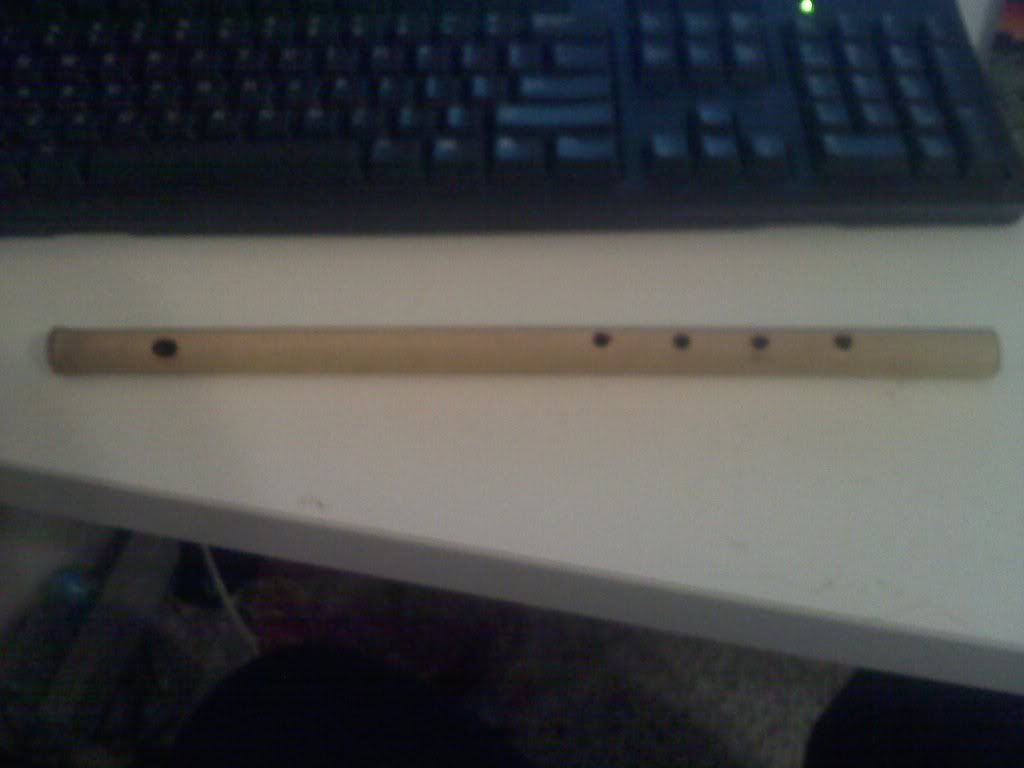
Homemade Bamboo Flute Troubles.
Moderators: Classitar, pied_piper, Phineas
Homemade Bamboo Flute Troubles.
So I'm a weekend survivalist, and I can survive by myself in Florida pretty easily. My record is 2 weeks with not so much as a knife. So I decided since I knew how to survive, it was time to thrive. I took a piece of bamboo about 15" long sanded it down with a piece of sandstone until 1 end was plugged and one was open. I took a twig around 1/4" and burned 1 hole about an inch away from plugged end (this one I made a little wider), then traveled 5 or 6 inches down and made 4 more holes an inch apart. It might just be me but I can't seem to get a sound to come out of the flute. I'll post pictures (The closed end is on the left in this picture), is it me or is it my flute?


- pied_piper
- Posts: 1962
- Joined: Sat Mar 31, 2007 1:31 pm
- Location: Virginia
Re: Homemade Bamboo Flute Troubles.
Have you ever played a flute before? If not, you may not be blowing correctly. Place the flute so that the embouchure hole (blow hole) is very slightly covered to halfway covered by your lower lip. Then you need to form your lips to a small opening and blow so that the airstream splits on the far side of the hole opposite from your lips. Think of spitting a grain of rice and you will be close to the proper lip position. See if you can get a sound that way.
"Never give a flute player a screwdriver."
--anonymous--
--anonymous--
Re: Homemade Bamboo Flute Troubles.
What does that mean exactly. How did you sand something down until the end plugged?Allenph wrote: I took a piece of bamboo about 15" long sanded it down with a piece of sandstone until 1 end was plugged and one was open.
You don't need to sand Bamboo, You remove all the nodes except the one at the end and simply make your holes.
Can you explain your comment more so that we can understand exactly how you sanded until an end was plugged?
Joe B
-
ObscureStar
- Posts: 11
- Joined: Tue Feb 19, 2013 1:36 pm
Re: Homemade Bamboo Flute Troubles.
You're going to want to learn a little math if you really want to do this.
The diameter of the inner wall of the bamboo and the length of the bamboo are very important to the size and spacing of the mouthpiece and holes.
You'll also want to sand the far side of the inside of the mouthpiece at an angle to get really good tone out of it. There are a bunch of websites which tell you how to construct your own flute out of PVC pipe. I'd suggest you start there as PVC has uniform properties and the websites with info on building a PVC flute can spell out the mathematics involved a bit better than I'm likely to transcribe.
I might also suggest you start with an end-blown flute like a shakuhachi. They are end-blown, removing the problem of the distance and size of the mouthpiece as an obstacle and the traditional shakuhachi is pentatonic scale so there are fewer holes (and therefor less math) to wrestle with.
The diameter of the inner wall of the bamboo and the length of the bamboo are very important to the size and spacing of the mouthpiece and holes.
You'll also want to sand the far side of the inside of the mouthpiece at an angle to get really good tone out of it. There are a bunch of websites which tell you how to construct your own flute out of PVC pipe. I'd suggest you start there as PVC has uniform properties and the websites with info on building a PVC flute can spell out the mathematics involved a bit better than I'm likely to transcribe.
I might also suggest you start with an end-blown flute like a shakuhachi. They are end-blown, removing the problem of the distance and size of the mouthpiece as an obstacle and the traditional shakuhachi is pentatonic scale so there are fewer holes (and therefor less math) to wrestle with.